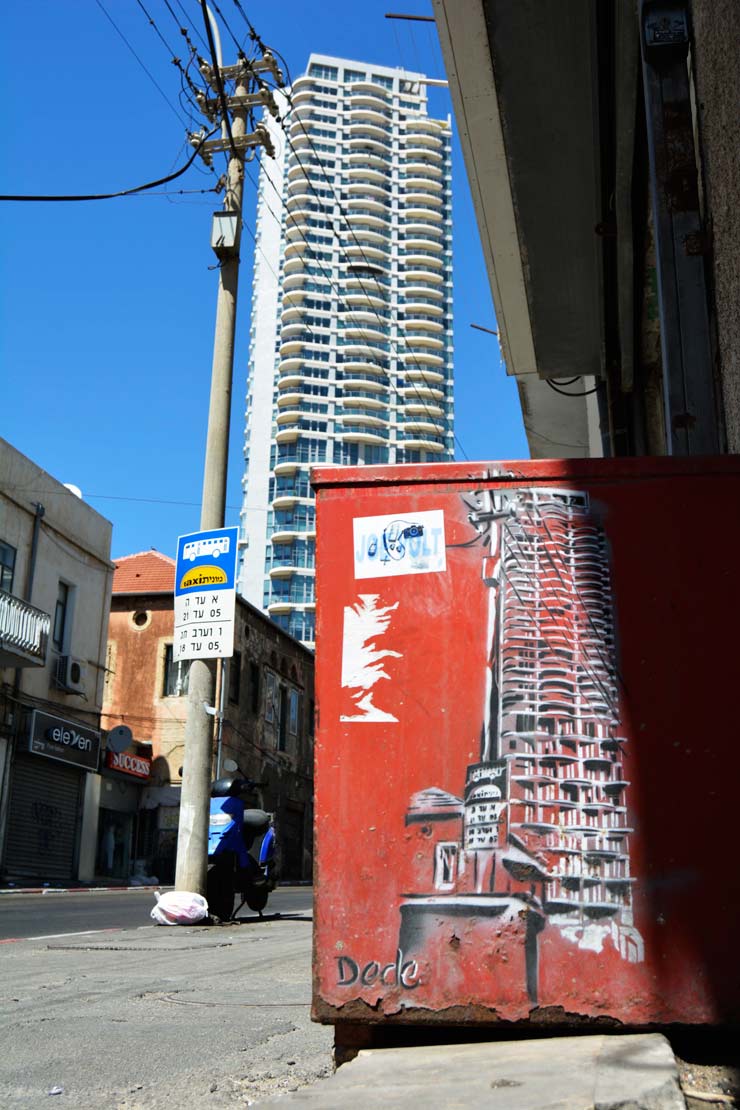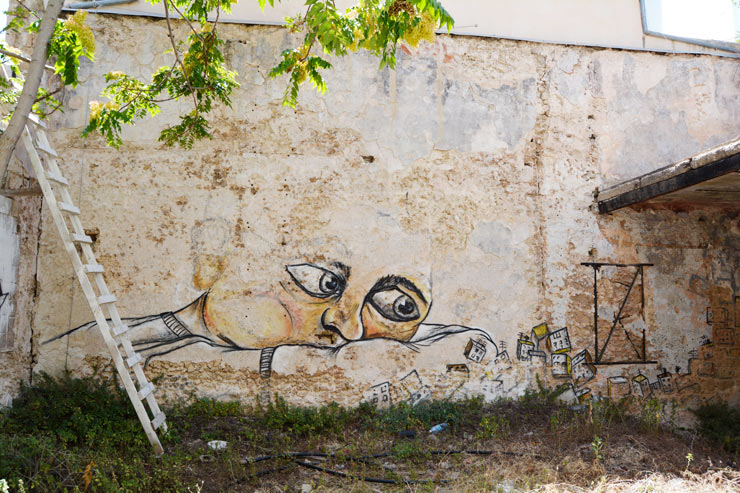“Site-specific” is a term employed by some Street Art conceptualists often today, but the relevance of location to the piece on the street may not be as clear to the viewer as the artist would have intended even when it is the product of a high-minded process for selection. This is not the case in Tel Aviv where Street Artist Dede is taking “site-specific” quite seriously in a new series of pieces where a stenciled view of a city scene appears precisely where this view can also be observed with the bare eye. By producing this visual double-take, the location and stencil placement instantly invoke a closer examination and consideration of just what is being called into view, and perhaps to ask why.
Dede (photo © Yoav Litvin)
It could be a scene you otherwise would have overlooked, but somehow now it is elevated by the fact that the artist has taken the effort to cut and spray a stencil here and probably did so with purpose. It’s a highly effective method of sharpening our focus and we’re glad that it has brought Yoav Litvin to BSA today to share his recent interview with Dede about the series as well as to discuss his views on life in Israel during this time of intensified conflict with Palestine. Yoav also shares his photos from these new site-specific installations as well as other examples of the artists’ stylistically eclectic offerings.
‾‾‾‾‾‾‾‾‾‾‾‾‾‾‾‾‾‾‾‾‾‾‾‾‾‾‾‾‾‾‾‾‾‾‾‾‾‾‾‾‾‾‾‾‾‾‾‾
Belonging, Territoriality and Healing in Israel: An interview with Dede
by Yoav LitvinWhenever I visit a city, I try to dedicate time to venturing on the streets in search of art as a way of assessing the local and current creative vibe. By chance, I was in Israel when the most recent violent conflict erupted between the Israeli army (the IDF) and Hamas in the Gaza strip. During my two-week long visit there, I spent countless hours arguing against violence and for peace and reconciliation; against the powerful interest groups and for the people.
Dede. Close up. (photo © Yoav Litvin)
Together with Dede, a local street artist, I walked through various neighborhoods in Tel Aviv in search of art. Seeing the beautiful and at times chaotically colorful walls, I once again felt the positive and potentially healing power of art, even more so in this dire context of war. I have always believed street art can represent a creative, non-violent form of rebellion. It can serve to challenge the powerful, the violent and the selfish and offer an unfiltered, free and raw voice- from the people to the people! As composer and playwright Jonathan Larson epitomized in his famous quote: “The opposite of war is not peace… it’s creation!”
Here I talk with Dede about his current series of site-specific stencils, and how these may reflect some of the realities in this troubled town and part of the world. Additionally we see his most recent large-scale murals, which revolve around relevant issues of belonging, displacement and escape.
Yoav Litvin: What’s your thought process behind these site-specific installations?
Dede: I began this ongoing site-specific series of stencils at the end of 2013. It stems from many thoughts/ideas on technique and the ways in which we are exposed to street art today. Importantly, I was very much influenced by a text written by the cultural critic Walter Benjamin, The Work of Art in the Age of Mechanical Reproduction and its ramifications on our modern way of life.
Dede (photo © Yoav Litvin)
Yoav Litvin: Why did you choose the locations you did?
Dede: Every location has its own reasons, each attempting to focus attention on an important issue within our modern urban reality. These include the housing crisis in Israel, urban development and restoration of historical landmarks/buildings.
Yoav Litvin: There is a long-standing conflict surrounding territory in Israel. Do your site-specific installations address it? How?
Dede: There is always conflict on territory/resources, perhaps everywhere in the world but I see it clearly here in Tel Aviv. Just like in any capitalist society, real estate here is bought and sold in accordance with personal interests and therefore can be controversial in a community. For example- see my stencil of the tower that was built in Neve Tzedek in Tel Aviv (below). The rest of the neighborhood is only two stories high and many residents were against the construction of such a tall building- there were petitions and protests but eventually those with money won out. Land is expensive and Tel Aviv is prime real estate in Israel. There is a constant increase in housing prices and this is making Tel Aviv a city exclusively for the wealthy.
Dede (photo © Yoav Litvin)
Yoav Litvin: I had a lot of fun shooting these stencil installations, trying to capture the art together with its subject. Are you trying to create a dialog between artist and documenter? How do you view street art documenters within the scene, especially with the central role of the Internet, social media and photo sharing?
Dede: Documentation is extremely important for street art, because of this art form’s inherently ephemeral nature. However, seeing a photograph can never replace the feeling of standing in front of a piece and personally experiencing it. Documentation conveys the idea as best as possible without experiencing it first hand. In this series of stencils, documentation is a central theme.
Stencils are regularly cut based on photographs, and this series was sprayed at the location the pictures were taken. Thus, the photographer has a central role in capturing both subject and the art it conveys. My notion was to challenge the documenter and in turn, the viewer of the photo. This work was intended for an audience that relies on social networks for its street art consumption.
Dede (photo © Yoav Litvin)
Yoav Litvin: How has your art evolved since last we spoke? Is it becoming more personal or do you feel you are reaching out to the public with relevant issues to the community?
Dede: This is a question I ask myself all the time. Honestly, I cannot really say what has changed in my art. I let my art lead me, and do not try to lead it. I feel I am trying to evolve in both realms you mention, focusing on my personal style, but also my interaction with the community, both locally and globally.
Dede (photo © Yoav Litvin)
Yoav Litvin: I find street art to be an excellent device for an artist to communicate with the surrounding communities. Do you try to appeal to a strictly Israeli audience in Tel Aviv? How do you engage the Palestinian population, for example in neighboring Jaffa?
Dede: Street art engages everyone everywhere, especially today in the age of the internet. As an artist in Tel Aviv, Israel, I am aware that my art reaches Palestinians as well as Israelis. In fact, I often correspond with Palestinian artists, and am pleased when they enjoy, interested and/or are emotionally touched by my work. I feel my work is a personal reflection that appeals to people everywhere, not just Israelis, Palestinians or any other category of people.
I love painting in Jaffa, and during your last visit we walked through an abandoned building in Jaffa in which I and friends painted. Local residents are very positive and appreciate street art. I wish art could bridge all gaps between peoples here and everywhere.
Dede (photo © Yoav Litvin)
Dede. Jaffa as seen from Tel Aviv. (photo © Yoav Litvin)
Yoav Litvin: One cannot discuss Israel today without addressing the current violence. Has it affected your art? How so?
Dede: The situation here is very complicated and disturbing. It is a conflict that has been going on for years. This conflict has affected my art and inspired me to create in many ways. I love Tel Aviv, but during wars it is a difficult place to live in. One of the central themes in my works is the need to escape to a safer place, whether in the physical or emotional realm. This stems from different motivations; mental, social and political. I do not believe any citizen should live in a state of fear anywhere, and my art conveys these notions.
Dede and Latzi collaboration. (photo © Yoav Litvin)
Dede (photo © Yoav Litvin)
Dede (photo © Yoav Litvin)
Dede (photo © Yoav Litvin)
Dede’s studio. (photo © Yoav Litvin)
Interview written, edited and translated by Yoav Litvin. Mr. Litvin is the author and photographer of the recently published book Outdoor Gallery – New York City by Gingko Press.
For more information regarding Yoav Litvin click HERE. For more information regarding Dede, click HERE
<<>>><><<>BSA<<>>><<<>><><BSA<<>>><><<>BSA<<>>><<<>><><BSA Please note: All content including images and text are © BrooklynStreetArt.com, unless otherwise noted. We like sharing BSA content for non-commercial purposes as long as you credit the photographer(s) and BSA, include a link to the original article URL and do not remove the photographer’s name from the .jpg file. Otherwise, please refrain from re-posting. Thanks! <<>>><><<>BSA<<>>><<<>><><BSA<<>>><><<>BSA<<>>><<<>><><BSA
Other Articles You May Like from BSA:
So here's our weekly interview with the street, this week featuring A Visual Bliss, Amok Island, Banjo, BD White, Betty Page, Corografico, D7606, Daek, Deal9, El Sol 25, Likes, Maupal, Nepo, and Q...
“What we do to the mountains we do to ourselves,” says the blocky hand written text across the Native American activists Klee and Princess Benally, and on the face of it you’re bound to agree with thi...
In the last week, we’ve marked the first anniversary of the war now taking place in Ukraine with an installation by exiled Ukrainian street artist/muralist Waone in New York and exiled Russian artist...
"Trash-pop" is a label that can be applied to so much that you see and hear today as an inheritor of massive consumer culture that has raged across the globe for decades. Ana Barriga in conjunctio...
Our weekly focus on the moving image and art in the streets. And other oddities. Now screening: 1. "We Still Fight" by South Italy Street Art2. "No Pain No Gain" Graffiti & Tattoo with Br...
 BROOKLYN STREET ART LOVES YOU MORE EVERY DAY
BROOKLYN STREET ART LOVES YOU MORE EVERY DAY























